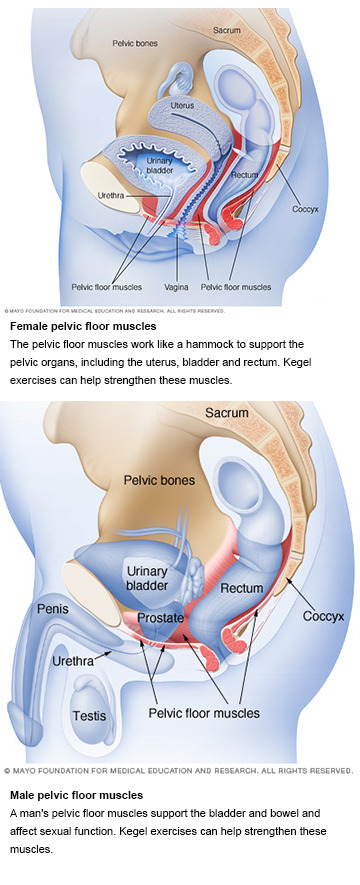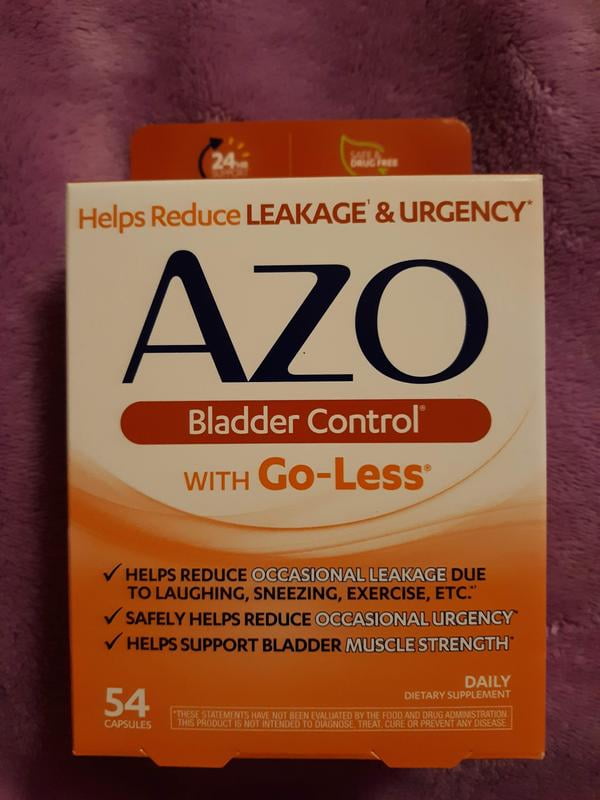Occasional Urine Leakage
Urinary incontinence means a person leaks urine by accident. While it may happen to anyone, urinary incontinence is more common in older people, especially women. Incontinence can often be cured or controlled. Talk to your healthcare provider about what you can do.
What happens in the body to cause bladder control problems? The body stores urine in the bladder. During urination, muscles in the bladder tighten to move urine into a tube called the urethra. At the same time, the muscles around the urethra relax and let the urine pass out of the body. When the muscles in and around the bladder don’t work the way they should, urine can leak. Incontinence typically occurs if the muscles relax without warning.
Causes of Urinary Incontinence
Incontinence can happen for many reasons. For example, urinary tract infections, vaginal infection or irritation, constipation. Some medicines can cause bladder control problems that last a short time. When incontinence lasts longer, it may be due to:
- Weak bladder muscles
- Overactive bladder muscles
- Weak pelvic floor muscles
- Damage to nerves that control the bladder from diseases such as multiple sclerosis, diabetes, or Parkinson’s disease
- Blockage from an enlarged prostate in men
- Diseases such as arthritis that may make it difficult to get to the bathroom in time
- Pelvic organ prolapse, which is when pelvic organs (such as the bladder, rectum, or uterus) shift out of their normal place into the vagina. When pelvic organs are out of place, the bladder and urethra are not able to work normally, which may cause urine to leak.

Most incontinence in men is related to the prostate gland. Male incontinence may be caused by:

- Prostatitis—a painful inflammation of the prostate gland
- Injury, or damage to nerves or muscles from surgery
- An enlarged prostate gland, which can lead to Benign Prostate Hyperplasia (BPH), a condition where the prostate grows as men age.
If you have a hard time controlling when urine comes out of your body, it’s called urinary incontinence. It means your body has lost some control over your bladder. It can be frustrating. Your pelvic floor muscles help you hold your urine. You may leak if the muscles are weakened from pregnancy, prostate surgery, or being overweight. You can strengthen your muscles to improve. For the approximately 16% of people over the age of 18 who have an overactive bladder (OAB), this kind of upsetting incident can become a regular occurrence. Even if they make it to the bathroom in.
Many women experience an increase in vaginal discharge during pregnancy or find that they leak urine at times. However, a clear and odorless fluid coming from the vagina could be leaking amniotic. Bladder does not completely empty; Bladder overfills and pressure causes accidental leakage of urine; Bladder is unable to hold urine; The brain and spinal cord are the central chains of command that transmit signals and messages to and from the bladder. Photo Source: 123RF.com. Bladder Nerves in the Sacral Spine.
Diagnosis of Urinary Incontinence
The first step in treating incontinence is to see a doctor. He or she will give you a physical exam and take your medical history. The doctor will ask about your symptoms and the medicines you use. He or she will want to know if you have been sick recently or had surgery. Your doctor also may do a number of tests. These might include:
- Urine and blood tests
- Tests that measure how well you empty your bladder
In addition, your doctor may ask you to keep a daily diary of when you urinate and when you leak urine. Your family doctor may also send you to a urologist, a doctor who specializes in urinary tract problems.
Types of Urinary Incontinence
There are different types of incontinence:
- Stress incontinence occurs when urine leaks as pressure is put on the bladder, for example, during exercise, coughing, sneezing, laughing, or lifting heavy objects. It’s the most common type of bladder control problem in younger and middle-age women. It may begin around the time of menopause.
- Urge incontinence happens when people have a sudden need to urinate and cannot hold their urine long enough to get to the toilet. It may be a problem for people who have diabetes, Alzheimer’s disease, Parkinson’s disease, multiple sclerosis, or stroke.
- Overflow incontinence happens when small amounts of urine leak from a bladder that is always full. A man can have trouble emptying his bladder if an enlarged prostate is blocking the urethra. Diabetes and spinal cord injuries can also cause this type of incontinence.
- Functional incontinence occurs in many older people who have normal bladder control. They just have a problem getting to the toilet because of arthritis or other disorders that make it hard to move quickly.
Treatment for Urinary Incontinence
Today, there are more treatments for urinary incontinence than ever before. The choice of treatment depends on the type of bladder control problem you have, how serious it is, and what best fits your lifestyle. As a general rule, the simplest and safest treatments should be tried first.
Bladder control training may help you get better control of your bladder. Your doctor may suggest you try the following:
- Pelvic muscle exercises (also known as Kegel exercises) work the muscles that you use to stop urinating. Making these muscles stronger helps you hold urine in your bladder longer. Learn more about pelvic floor exercises and how to do them.
- Biofeedback uses sensors to make you aware of signals from your body. This may help you regain control over the muscles in your bladder and urethra. Biofeedback can be helpful when learning pelvic muscle exercises.
- Timed voiding may help you control your bladder. In timed voiding, you urinate on a set schedule, for example, every hour. You can slowly extend the time between bathroom trips. When timed voiding is combined with biofeedback and pelvic muscle exercises, you may find it easier to control urge and overflow incontinence.
- Lifestyle changes may help with incontinence. Losing weight, quitting smoking, saying “no” to alcohol, drinking less caffeine (found in coffee, tea, and many sodas), preventing constipation and avoiding lifting heavy objects may help with incontinence. Choosing water instead of other drinks and limiting drinks before bedtime may also help.
For more tips to keep your bladder healthy, visit 13 Tips to Keep Your Bladder Healthy.

Incontinence and Alzheimer’s Disease
People in the later stages of Alzheimer’s disease often have problems with urinary incontinence. This can be a result of not realizing they need to urinate, forgetting to go to the bathroom, or not being able to find the toilet. To minimize the chance of accidents, the caregiver can:
- Avoid giving drinks like caffeinated coffee, tea, and sodas, which may increase urination. But don’t limit water.
- Keep pathways clear and the bathroom clutter-free, with a light on at all times.
- Make sure you provide regular bathroom breaks.
- Supply underwear that is easy to get on and off.
- Use absorbent underclothes for trips away from home.
For more ways to deal with incontinence and other common medical problems in someone with Alzheimer’s, visit Alzheimer’s Disease: Common Medical Problems.
Managing Urinary Incontinence

Besides bladder control training, you may want to talk with your doctor about other ways to help manage incontinence:
- Medicines can help the bladder empty more fully during urination. Other drugs tighten muscles and can lessen leakage.
- Some women find that using an estrogen vaginal cream may help relieve stress or urge incontinence. A low dose of estrogen cream is applied directly to the vaginal walls and urethral tissue.
- A doctor may inject a substance that thickens the area around the urethra to help close the bladder opening. This can reduce stress incontinence in women. This treatment may need to be repeated.
- Some women may be able to use a medical device, such as a urethral insert, a small disposable device inserted into the urethra. A pessary, a stiff ring inserted into the vagina, may help prevent leaking if you have a prolapsed bladder or vagina.
- Nerve stimulation, which sends mild electric current to the nerves around the bladder that help control urination, may be another option.
- Surgery can sometimes improve or cure incontinence if it’s caused by a change in the position of the bladder or blockage due to an enlarged prostate.
How To Stop Urine Leakage
Even after treatment, some people still leak urine from time to time. There are bladder control products and other solutions, including adult diapers, furniture pads, urine deodorizing pills, and special skin cleansers that may make leaking urine bother you a little less.
Visit the National Institute of Diabetes and Digestive and Kidney Diseases for more information on urinary incontinence in men and urinary incontinence in women.
Read about this topic in Spanish. Lea sobre este tema en español.
For More Information on Urinary Incontinence
National Association for Continence
800-252-3337 (toll-free)
memberservices@nafc.org
www.nafc.org
National Institute of Diabetes and Digestive and Kidney Diseases (NIDDK)
800-860-8747 (toll-free)
866-569-1162 (TTY/toll-free)
healthinfo@niddk.nih.gov
www.niddk.nih.gov
MedlinePlus
National Library of Medicine
www.medlineplus.gov
Simon Foundation for Continence
800-237-4666 (toll-free)
info@simonfoundation.org
www.simonfoundation.org
Urine Leakage Protection For Men
This content is provided by the NIH National Institute on Aging (NIA). NIA scientists and other experts review this content to ensure it is accurate and up to date.
Content reviewed: May 16, 2017